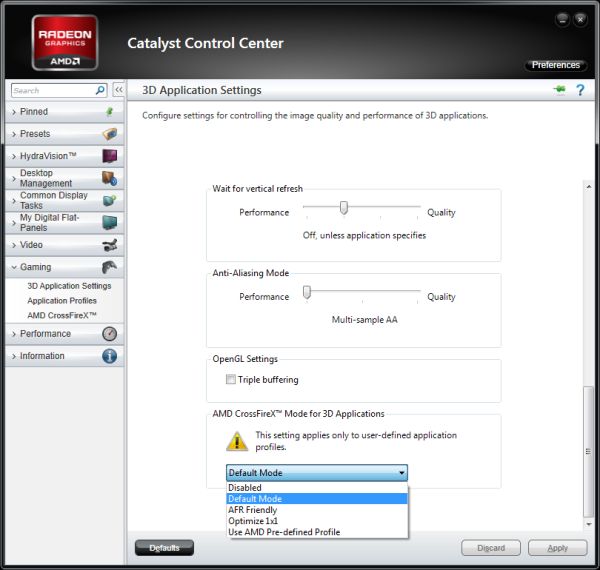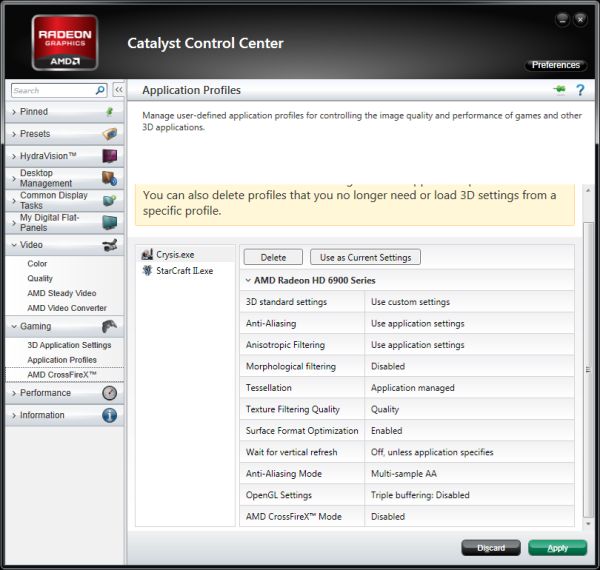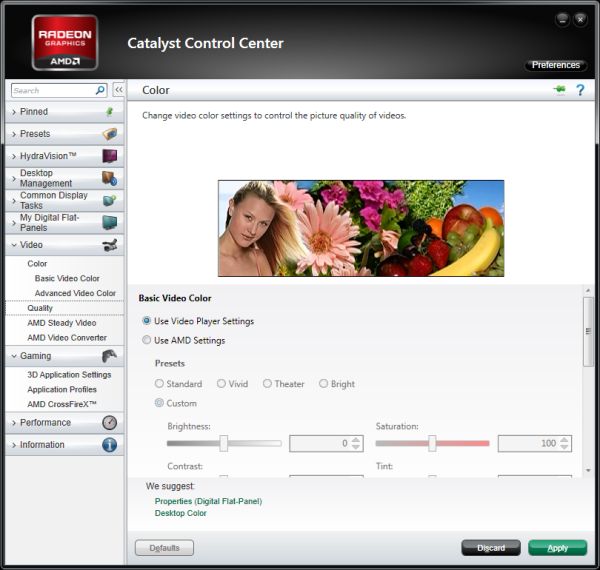AMD Releases Catalyst 12.1 Preview – Custom Application Profiles, HD3D CrossFire, & More
by Ryan Smith on December 13, 2011 1:00 AM ESTLater today AMD will be releasing the first preview for their Catalyst 12.1 driver set. AMD has been going through preview/beta drivers at a rapid pace in the last couple of months – we’ve seen 3 different 11.11 preview drivers in as many weeks – and as 11.12 nears, AMD is preparing for what 2012 and the Catalyst 12.x series will bring. It may sound like hyperbole to say that 2012 will be the biggest year yet for AMD’s Catalyst driver team, but it’s the truth. Graphics Core Next will be the biggest GPU architecture change for the company since R600 (2900XT) nearly 5 years ago, bringing with it a great deal of backend driver work that needs to be done, while the frontend team has their own goals and aspirations.
At the same time it’s going to give AMD the chance to close the book on 2011. 2011 brought with it some great developments out of the Catalyst team such as significant performance boosts for both Cayman (6900 series) GPUs and CrossFire across the board, while other groups delivered on more consumer-facing features such as SteadyVideo to go along with the launch of the Llano APU.
But 2011 also brought with it some technical debt and some reputational debt, all of which needs to be paid in 2012. AMD outright blew the launch of Rage by posting a faulty driver, Battlefield 3 in CrossFire mode did not work out of the box (i.e. without microstutter) even with nearly a month-long public beta and AMD’s close relationship with DICE, and CrossFire support for The Elder Scrolls V: Skyrim took the better part of a month to reach Radeon HD 5000 series owners. Not to kick the Catalyst team while they’re down, but for all that went well for them in 2011 they failed in other areas where they could least afford it. Thus 2012 becomes all the more important for AMD as they need to erase their debts from 2011.
Erasing those debts starts today for AMD, with the release of the Catalyst 12.1 preview driver. 12.1 won’t be the driver that buys AMD redemption – I think 11.11c is more important in that respect – but it is the driver that sets the pace for the year. And quite frankly it’s the driver that’s going to buy AMD a lot of goodwill, even if it only brings with it a few changes.

Custom Application Profiles As Implemented By NVIDIA
Of those few features I’m going to immediately dive in with what I think is the headline feature: custom application profiles. Ever since NVIDIA introduced custom application profiles so many years ago I have been a firm believer in their importance for GPU enthusiasts. While most games have been good about implementing anti-aliasing and anisotropic filtering controls, that’s about as much progress as they’ve made. With the introduction of driver enhancements like Adaptive/Transparancy anti-aliasing, coverage sample/EQ anti-aliasing, tessellation clamping, and the widespread use of multi-GPU, the idea that you can set & forget your drivers on a global level has become antiquated. These features deserve to be used, and custom application profiles are the most efficient way of using them.
For more than 4 years now I’ve asked AMD for this feature – in meetings and in articles – but it hasn’t been something where we’ve seen eye-to-eye. AMD made some progress in 2010 with the introduction of Catalyst Application Profiles (CAP) to distribute out of band profile updates, and while CAP was a big step forward for AMD, the C I was looking for was custom. Tools like Radeon Pro have filled the gap in the meantime, but it’s never the same thing as having such functionality built into the driver itself, especially when 3rd party tools will never have the reach of 1st party tools.
With Catalyst 12.1 AMD is finally taking application profiles to their logical extension by allowing for custom application profiles, and I couldn’t be happier. As is the case with NVIDIA, AMD is allowing users to create new application profiles and to modify the application profiles distributed through drivers and CAP updates. This not only includes settings traditionally available through the driver, but for the first time AMD is opening up CrossFire – you can now force various CrossFire modes by using a custom profile.
Breaking things down a bit, if you have used NVIDIA’s custom profiles in the past then you should find the functionality nearly the same. All of AMD’s control panel settings can be saved to a custom profile which will then be used alongside the game the profile is for. For example this allows for forcing MSAA in Starcraft II or clamping tessellation factors in HAWX 2 without the need to set (and then unset) these features at a global level. If you’re an image quality purist, and particularly if you’ve spent a significant amount of money on GPUs to achieve this, then the value of custom profiles cannot be understated.
As for multi-GPU users, they will be the other significant group to benefit from custom profiles. Previously if you wished to force CrossFire on an unsupported application you needed to rename the executable to match a game AMD had a profile for, and then hope that specific CF mode worked. With custom profiles AMD is enabling several different CF modes: default (which uses whatever CF profile AMD has defined for the game), AFR Friendly (forced AFR), Optimize 1x1, and Use AMD Pre-define Profile, which allows a custom profile to have a CF mode from another game mapped to it (similar to NVIDIA’s SLI compatibility bits). Even disabling CF on a per-profile basis is an option here, though we found that it suffers from the same quirk that NVIDIA’s implementation does: the second GPU is decoupled but CF isn’t actually disabled, so games that can detect CF (such as Crysis) will follow their AFR friendly render paths as they still see CF enabled.
At this point all of the necessary functionality is present and accounted for, and in our tests we’ve found it to work without any hitches. AMD is finally at parity with NVIDIA in providing this small but crucial feature.
With that said, while AMD has done a great job implementing the functionality of custom application profiles the interface could use some further work. The whole implementation still feels like it’s been shoehorned into AMD’s existing 3D Applications Setting panel; AMD doesn’t sufficiently separate the concept of global and custom profile settings, as you use the same control panel to make changes to both types of settings. It’s possible (and likely) that you’ll accidentally set your global settings at least once when trying to save a custom profile.
Furthermore whereas NVIDIA uses application detection to pre-populate a list of profiles, AMD has no such detection. In order to create a profile you need to first select your settings in the 3D Application Settings panel and then save those settings to a new profile, a process that involves hunting down the executable of the game. Of course NVIDIA’s detection system isn’t perfect and you’ll have to follow a similar process at times, but if you have a large Steam library you’ll appreciate not having to drill down through several directories to find the right executable for each game.
Once a custom profile has been set however, AMD actually has a second panel that lists all of the custom profiles and their settings, and allows you to delete them. Note that this is just a listing of custom profiles, so pre-defined profiles continue to remain hidden. Custom and pre-defined profiles play well together for the most part, although if you create a custom profile for a game that already has a pre-defined profile AMD will warn you that the custom profile will override the pre-defined profile.

Overall if you’re a previous NVIDIA user who has missed custom application profiles you should be quite content with AMD’s latest addition. Otherwise if you’ve never had the opportunity to use custom application profiles before then you’re in for a treat.
Rounding out the changes to the Catalyst Control Center, along with the addition of custom application profiles AMD has also made some minor tweaks to the Video Color and Video Quality control panels. There’s no new functionality to speak of, but they have been tweaked to simplify their use.
Finally, outside of the CCC AMD has also added a couple new features to their driver, along with some specific performance enhancements. 3D users will find that quad-buffer (gaming) 3D finally works in conjunction with CrossFire, while TV users will find that AMD now supports frame-packed 3D over HDMI at 1080p30, on top of their existing support for 1080p24 and 720p60. A quick check of the HDMI specification lists frame-packed 1080p30 as an optional (secondary) resolution, but it’s there for the TVs that support it. Meanwhile for performance AMD is still hard at work on Skyrim; 6900 series users can look forward to up to 10% better performance in Skyrim when using MSAA alongside CrossFire.
Update: Released. http://support.amd.com/us/kbarticles/Pages/Catalyst121Previewdriver.aspx




















59 Comments
View All Comments
poohbear - Tuesday, December 13, 2011 - link
Custom application profiles is long overdue! i remember when i switched from Nvidia to AMD i was shocked they didnt have something so rudimentary! The last 3 months have been a mess for AMD in the driver department, to the point wherein they're releasing 3-4 driver versions a month from October- December! Their nomenclature for these driver releases are also a mess, 11.11a, 11.11 CAP drivers, 11.11 preview drivers, 11.11 performance drivers, i mean seriously it was getting absurd! If i had just switched to AMD in the fall of 2011 i'd be totally confused! They dropped the ball big time but hopefully they'll recover in winter 2011/12 and regain their reputation. Otherwise there's always Nvidia to go back to.piroroadkill - Tuesday, December 13, 2011 - link
Basically there's only one thing I want this for, turning on Morphological AA where games don't support AA. I'm looking at you, GTAIV.Revdarian - Tuesday, December 13, 2011 - link
Don't use MLAA, if you want a good AA for GTAIV use the SMAA 1.2 injector here:http://mrhaandi.blogspot.com/p/injectsmaa.html
much MUCH better quality, and almost no performance hit to speak of.
Personally i recommend using the config to start//stop AA use with keycode 145 = scroll-lock.
hechacker1 - Tuesday, December 13, 2011 - link
I'd love to use something like SMAA, but for multiplayer games I wouldn't dare or risk getting banned since this "injects" SMAA into the game code. Though I'm really not sure how this affects the game. Perhaps it only applies a filter above the game layer.Revdarian - Tuesday, December 13, 2011 - link
Yes, for multiplayer your best bet is to try and contact tech support with the proper program and ask if it would trigger it, or if it could be added to a whitelist.This would be an uphill battle, but with enough people interested it could work.
In any case in the future we will see SMAA directly in games, like FXAA and the improved MLAA can be found already.
MTDEW - Tuesday, December 13, 2011 - link
The way profiles are implemented is clunky at best.Like i wanted to just "tweak" the pre-defined Skyrim profile to force 16x aniso,and it doesn't let you do that, you either override the entire default profile or stick with what AMD has for the pre-defined profile.
It would be a lot nicer to be able to load the pre-defined profile first, then just adjust it as needed.
The way it is now, you choose pre-defined or you set everything manually.
I'm not biased to red or green either way, but Nvidia definitely does profiles better.
Just as mentioned above , it seems shoehorned in.
I don't see how it could have possibly have taken them so long to implement a much needed feature and still not get it quite right.
Don't get me wrong, i love my 6950's , but my wife's GTX 470 still makes me jealous sometimes.
MrSpadge - Tuesday, December 13, 2011 - link
"It would be a lot nicer to be able to load the pre-defined profile first, then just adjust it as needed."Totally agreed! Like "If I don't change it, continue to use what you think is good."
MrS
chizow - Tuesday, December 13, 2011 - link
Agreed, its not parity with Nvidia's profiling yet but its a big step in the right direction for AMD. Its just unnecessarily redundant to have to re-create the profile blindly from scratch, which will be the case as long as this remains true:AT - "Note that this is just a listing of custom profiles, so pre-defined profiles continue to remain hidden."
Arbie - Tuesday, December 13, 2011 - link
On a WinXP Pro / HD5770 system, it's been 18-24 months since any version of CCC would install and launch. The drivers install OK, but not the interface.
I once stripped every reference to CCC off the machine and out of the registry, reinstalled for the umpteenth time, and it ran... until the next driver update. Then CCC was permanently broken again. It's not worth the trouble to keep it going, so I do without.
From the forums I know that a number of people have this problem, but AMD is either unaware or the affected user base is too small to address it.
erple2 - Tuesday, December 13, 2011 - link
Does Microsoft even support Windows XP anymore if you're not an enterprise user?